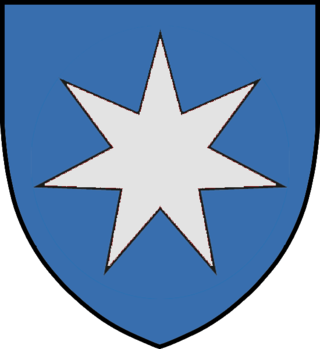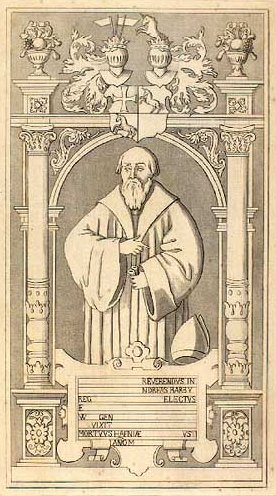
Johan Jepsen Ravensberg (1452 - 14 April 1512) was a Danish clergyman and statesman. He served as King's Chancellor from 1486 to 1493 and as Bishop of Roskilde from 1500 to 1512.

Johan Jepsen Ravensberg (1452 - 14 April 1512) was a Danish clergyman and statesman. He served as King's Chancellor from 1486 to 1493 and as Bishop of Roskilde from 1500 to 1512.
Ravensberg was born in 1452 to Privy Councillor Jep Jensen Ravensberg (died 1481) and Else Albertsdatter Krag. He was the brother of Privy Councilor Albert Jepsen Ravensberg. [1] His father owned Kindholm at Kyndby near Holbæk and was lensmand of Haraldsborg at Roskilde and Ravnsborg on Lolland. [2] He was sent to Cologne to study when he was 18 years old. He is most likely identical to one Johannes Jacobi de Dacia, who enrolled at the university in Cologne in 1471. [1]
Ravensberg began his ecclesiastical career as a parish priest on Lolland. He was shortly thereafter appointed as canon in Roskilde and then as archdean (lrkedegn) in Viborg. In 1496, during the reign of John of Denmark, he was appointed as provost (domprovst) of Lund. In 1499, he was appointed as dean of Roskilde. In 1500, he was appointed as Bishop of Roskilde. His status as Bishop of Roskilde was confirmed by the pope in 1501. On 18 February 1512, due to poor health and by agreement with King John, he left the office and was replaced by Lave Urne (1467–1529). [1]
In 1486–93, Ravensberg served as the King Chancellor (Kongens Kansler) and a member of the Privy Council. [3] In 1492–93, he participated in negotiations in the Netherlands, England and Scotland. In 1502, he was in Norway to assist Henrik Krummedige in the conflict with Knut Alvsson. According to the Skibby Chronicle , he was involved in the assassination of Alvsson. The same source accuses him of having encouraged the assassins of Poul Laxmand to murder him. [1] [2]
Ravensborg died at Hjortsholm on 14 April 1512. He is buried in the northern side of the central nave of Roskilde Cathedral. Three of the cathedral's bells date from his years as bishop, including the largest of them (stormklokken).

Eric IV, also known as Eric Ploughpenny or Eric Plowpenny, was King of Denmark from 1241 until his death in 1250. His reign was marked by conflict and civil wars against his brothers.

Kongens Lyngby is the seat and commercial centre of Lyngby-Taarbæk Municipality in the northern suburbs of Copenhagen, Denmark. Lyngby Hovedgade is a busy shopping street and the site of a branch of Magasin du Nord as well as Lyngby Storcenter. The district is also home to several major companies, including COWI A/S, Bang & Olufsen, ICEpower a/s and Microsoft. The Technical University of Denmark relocated to Lyngby from central Copenhagen in the 1970s. Lyngby station is located on the Hillerød radial of Copenhagen's S-train network.

The Hvide clan was a medieval Danish clan, and afterwards in early modern era a Danish noble surname of presumably one surviving branch of leaders of that clan. Before the 16th century it was not used as a surname. It signified the color white.

St. Catherine's Priory, Roskilde was a Danish priory of Dominican friars located in Roskilde. It was established in 1231 and dissolved during the Reformation. In 1699, the private house which replaced the Priory, became the Lutheran Roskilde Adelige Jomfrukloster, a women's collegiate foundation.

Henrich Krummedige, was born circa 1464 in Norway and died in 1530. He was a Danish-Norwegian nobleman and a member of both the Norwegian and Danish National Councils (Rigsråd) and played an extensive role in the politics of the era. He served as commanding officer of the Bohus Fortress in Norway from 1489 to 1503.

The former Diocese of Roskilde was a diocese within the Roman-Catholic Church which was established in Denmark some time before 1022. The diocese was dissolved with the Reformation of Denmark and replaced by the Protestant Diocese of Zealand in 1537.

The Marshal of the Realm, was the chief advisor to the King on military matters concerning the infantry and cavalry. It was the third highest office in the country after the Steward of the Realm and the Chancellor. The Rigsmarsk was appointed by the king from among Danish-born nobles.

Christopher, Duke of Lolland, was the son of King Valdemar IV of Denmark and his wife, Helvig of Schleswig. Christopher was appointed duke in 1359 and also was selected to succeed as king.
Events from the 1510s in Denmark.
Events from the 1450s in Denmark.

Kongsdal /1280ndash]]1661: Tygestrup) is a manor house and estate located approximately 14 kilometres (8.7 mi) southwest of Holbaek, between Undløse and Mørkøv, Holbæk Municipality, some 60 km west of Copenhagen, Denmark. The three-winged main building from the 1590s was listed in the Danish registry of protected buildings and places in 1918.
Marianne Gaarden is a Danish prelate who is the 21st and current Bishop of Lolland-Falster.
Førslevgaard is a manor house and estate located close to Fuglebjerg, Næstved Municipality, approximately 90 kilometres southwest of Copenhagen, Denmark. It has since 1803 been owned by members of the de Neergaard family. The three-winged, Baroque-style main building was built for Carl Adolph von Plessen in 1726. It was listed on the Danish registry of protected buildings and places in 1918.

Beldringe is a manor house and estate located four kilometres southwest of Præstø, Vordingborg Municipality, Denmark. The estate was from 1774 to 1993 owned by members of the Raben/Raben-Levetzau family. The two-storey main building from 1561 and a large, half-timbered barn from the 1710s were listed on the Danish registry of protected buildings and places in 1918.
Lauge Beck, or Lave Beck, was a Danish landowner, regional judge of Zealand and royal treasurer. His holdings included Førslevgaard and Beldringe on Zealand and Havrelykke on Lolland as well as the feefsof Roskildegaard and Ringsted Abbey. He was the father of Sivert Beck.
Peder Bild was a Danish landowner and lensmann. He owned Sonnerupgaard and was lensmann of a number of fiefs in Denmark and Norway.

Just Høg was a Danish statesman and landowner. He served as the first Hofmeister of Sorø Academy from 1629 to 1640 and then as Chancellor of the Realm from 1640 to 1646. He was the owner of Ghorslev Manor on Stevns.

Andreas von Barby was a German-born nobleman in Danish service who served as "German Chancellor" under Christian III. He owned Selsø Manor on the Hornsherred peninsula.

Mads Eriksen Bølle was a Danish privy councillor, landowner and fiefholder. He was during the Count's Feud in opposition to Christian III and the introduction of Protestantism but was after the Reformation nonetheless allowed to keep his fiefs.
Tetz (Totzen) Rosengaard was a Danish cleric and statesman. He served as archdeacon at Roskilde Cathedral from 1440. From 1443 to 1453, under the reign of Christian I of Denmark, he also served as Royal Chancellor. He was fiefholder of Selsø in Hornsherred.